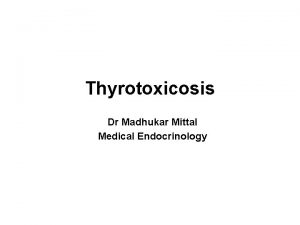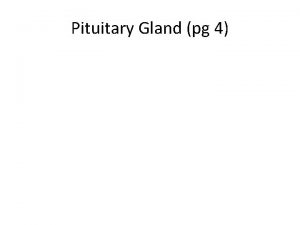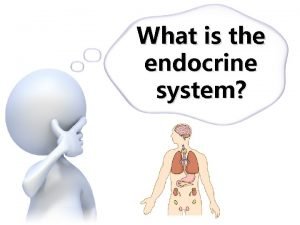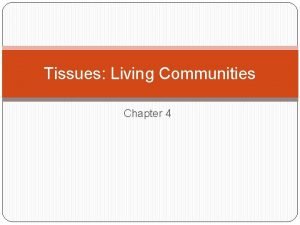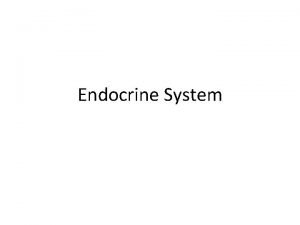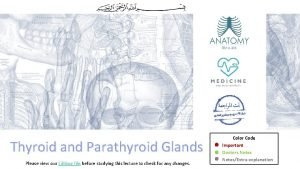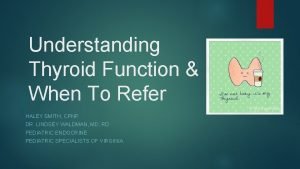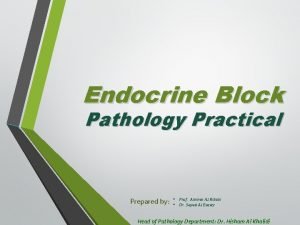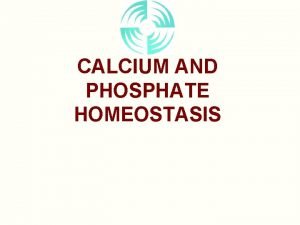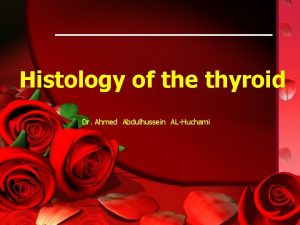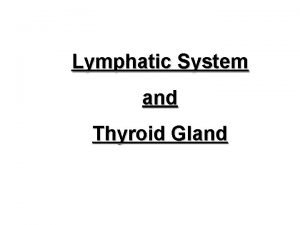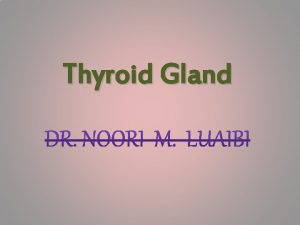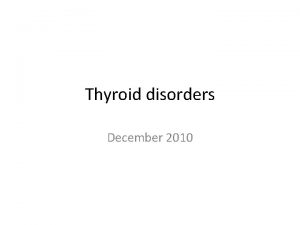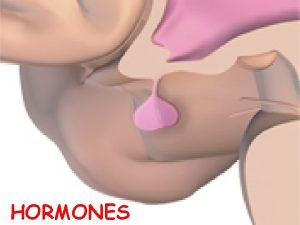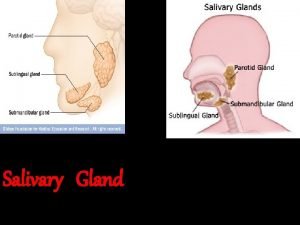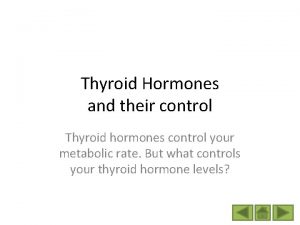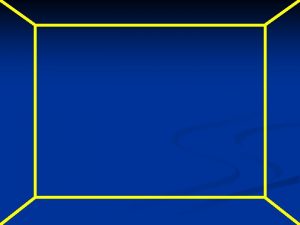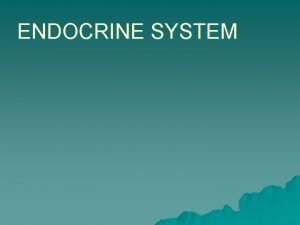Thyroid gland Thyroid hormones 28 thyroid gland consists












- Slides: 12

Thyroid gland

Thyroid hormones 2/8 • thyroid gland consists of two lobes weighing 20 g • thyroid cells surround follicles filled with a colloid (thyroglobulin – glycoprotein): storage • thyroid gland produces two active hormones: triiodothyronine (T 3) and tetraiodothyronine (T 4 or thyroxine) • I- is taken up by Na-K-pump dependent active transport – details are not known • thyroglobulin consists of two subunits; following synthesis they unite, carbohydrates are added; moves toward the follicles in small vesicles • upon entry the follicle, tyrosine side-chains are iodinated by a peroxidase enzyme that also helps coupling of two tyrosine side-chains through an O-bridge to form either T 3 or T 4 still within the protein chain • if needed, colloid is taken up by endocytosis, lysosomes digest the protein, T 3 and T 4 are released, iodine is cleaved from other tyrosines

Production and release of T 3/T 4 I- I- ER-Golgi Na+ ATP I- K+ peroxidase MIT DIT deiodinase lysosome T 3 T 4 endocytosis 3/8

Regulation of T 3/T 4 level 4/8 • T 3 is much more effective, then T 4 (thyroxine) • thyroxine is de-iodinated in the thyroid cells and other cells to T 3 • inactivation is achieved through de-iodination or deamination • thyroid hormones are transported in the blood attached to proteins (thyroxine-binding globulin 85%, thyroxine-binding prealbumin 15%, albumin 5%) • level of free hormones is very low - this is the active form – blood level is relatively constant • pulses in every two hours, maximum at early dawn, minimum in the afternoon – amplitude small • secretion is regulated by TSH, it also controls hypertrophy/atrophy of the gland • TSH in turn is regulated by TRH (tripeptide) • negative feedback dominates, but open-loop regulation is also present: fasting, stress decrease, cold (in newborns and animals) increase

TSH effects 5/8 • TSH receptor: glycoprotein with two subunits • TSH acts through different ways, most importantly by increasing c. AMP level • c. AMP facilitates uptake of iodine, synthesis of thyroglobulin and its iodination, formation of the thyronine structure, and colloid endocytosis • TSH causes hypertrophy of the thyroid cells • lack of thyroid hormones (e. g. caused by lack of iodine) leads to increased TSH production (no negative feedback) and goiter • the primary cause of goiter is the low iodine level in food and drinking water (rapid streams in the mountains) • in Africa the extensively cultivated manioc (mainly the bitter version) is rich in thiocyanites competing with iodid to enter thyroid cells • not proper preparation might lead to goiter • 200 million people live with goiter world-wide, 1 billion are close to insufficient I- supply

Effects of T 3/T 4 I. 6/8 • hydrophobic hormones, regulate expression of genes entering the cells • cytoplasmic receptor has strong affinity for T 3, direct role of T 4 is debated • receptor-hormone complex binds to TRE (thyroid response element) domains of the regulated genes, the process depends on a further nuclear protein (see c. AMP, CREB) • thyroid hormones have profound effects on development and morphogenesis • postnatal development of the nervous system (myelination, dendritic arborization, formation of synapses) depends on the thyroid hormones • these hormones are also indispensable for the functioning of the mature nervous system • direct effect on cartilage and bone; h. GH expression also depends on these hormones

Effects of T 3/T 4 II. 7/8 • morphogenetic role in tadpoles: thyroid lesion – giant tadpole; pulverized thyroid gland into the water – dwarf frogs • the hormones influence the turnover of glycoproteins in the subcutis; lack of hormones – protein accumulation, increased osmotic pressure, myxedema • strong effect on basal metabolic rate – calorigenic (except: brain, gonads, spleen) • thermogenesis increases, mechanism unknown • circulation increases (stroke volume and pulse rate, thus output of the heart) • hyperthyroidism is most commonly caused by autoimmune stimulation of TSH-receptors by antibodies formed against the receptors – usually no goiter, only Basedow-syndrome • increased food intake, but weight loss, increased O 2 consumption and respiration, faster circulation, hand tremor, agitation, emotional lability

Hypothyroidism 8/8 • food contains iodide in different concentrations: high in seafood, low in rapid streams in the mountains • 90% of the total iodide content is located in the thyroid gland • iodide supply can be assessed by the amount of iodide in the urine • endemic goiter and cretinism occur in remote geographical locations (mountain villages) because of iodide deficiency – there are 3 million cretins (hypothyroidism during development) world-wide • longitudinal growth is retarded, development of bones and teeth disturbed, wide, flat nose, protruding tongue, hoarse skin, enlarged belly (low muscle tone), lack of puberty, mental retardation • hypothyroidism in adults: decrease of basal metabolic rate, myxedema, enlarged tongue, hoarse skin, impaired intellectual and sexual functions, goiter, high cholesterol level • iodinated salt and oil


Anatomy of the thyroid gland Berne and Levy, Mosby Year Book Inc, 1993, Fig. 49 -1

Thyroid hormones thyronine structure tetraiodothyronine , T 4 triiodothyronine , T 3 dehydroalanine Fonyó: Orvosi Élettan, Medicina, Budapest, 1997, Fig. 30 -2, 4.

Goiter
 Cretinism diagram
Cretinism diagram Synthesis and secretion of thyroid hormones
Synthesis and secretion of thyroid hormones Pituitary gland hormones
Pituitary gland hormones Adrenal gland hormones
Adrenal gland hormones Multicellular exocrine glands can be classified
Multicellular exocrine glands can be classified Hypothyroid face
Hypothyroid face Parathyroid innervation
Parathyroid innervation Surfaces of thyroid gland
Surfaces of thyroid gland Pituitary gland thyroid
Pituitary gland thyroid Enlarged thyroid gland
Enlarged thyroid gland Four oval masses on posterior thyroid gland
Four oval masses on posterior thyroid gland Principal cells location
Principal cells location Spleen
Spleen

